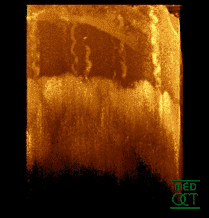(Sensors in the skin - does that sound like Frank Sinatra singing?)
Of the professors at Reading University, perhaps the one with the highest media profile is Kevin Warwick, well known for planting microchips inside himself as signalling devices. However, it seems that nature, as so often happens, got there first.
About a year ago, news emerged from the Hebrew University of Jerusalem, of evidence that the helically shaped sweat ducts in human skin act as an array of low-Q helical antennas. Recently, I saw this work presented at the Dielectrics 2009 conference in Reading.
We had already had a beanfeast of invited talks, but this last talk (presented by Paul Ben Ishai, now graduated, but whose PhD work it was) turned it into a banquet. He started by showing us some pictures: first an optical coherence tomograph showing a helical sweat gland, then a picture of a helical antenna array (from the US Navy, I think), and then the Wikipedia animation of which one frame is presented below.
Following computer simulations, he had rigged up an experimental array which could measure skin reflectance in the sub-Terahertz spectrum, and found this his subjects (who had just jogged around the perimeter of the Hebrew University in the summer heat) showed a marked dip in skin reflectance, especially between 88 and 102 Gigahertz. (Quick calculation: 100 GHz is a period of 1/100 of a nanosecond. The speed of light is 1 foot per nanosecond, which makes the wavelength 1/100 of a foot = 3 millimetres.)
It took about an hour or more for the skin of the subjects to recover to the calm state, where there is still a dip in reflectance, but much smaller. As for anti-perspirant creams, the subjects also took exercise where part of an arm was treated with a cream containing a snake venom-like synthetic tripeptide, and also a placebo cream. The "snakey" cream inhibited the drop in reflectance, while the placebo cream did not.
But where do dielectrics come in? We had already heard in the conference how tunnelling conduction might occur along a proton chain, as one’s sweat glands become active in this respect. If it ain’t a metal or a semiconductor, it’s a dielectric!
In the questions that followed the talk, someone asked something like what was the "evolutionary purpose" of this. Paul suggested that this was a "keep-in-touch" form of communication among early humans, before the development of language. This would lead to a conformity of skin architecture. Subsequent to the rise of language, geographical variation has produced a wide variety types, with people in the frozen north of Europe being particularly thin-skinned, in this part of the epidermis at least.
(In small group discussion as the conference broke up, someone objected to the questioner, says "that’s not science!" because his "evolutionary purpose" was too teleological. Some people would be unhappy in Paradise!)
So! If you thought dielectrics were just about capacitors, think again!
Reference: Yuri Feldman, Alexander Puzenko, Paul Ben Ishai, Andreas Caduff and Aharon J. Agranat, Human Skin as Arrays of Helical Antennas in the Millimeter and Submillimeter Wave Range
PHYSICAL REVIEW LETTERS PRL 100, 128102 (2008) 28 MARCH 2008 DOI:10.1103/PhysRevLett.100.128102
Featured page image: OCT image of the human skin adjacent to a finger-nail. The dark area at the lower edge of the image is the finger-nail, the striped area above are blood-vessels. Credit: University of Dortmund
Sensors In Your Skin?




Comments